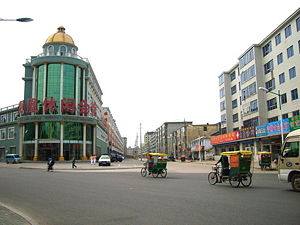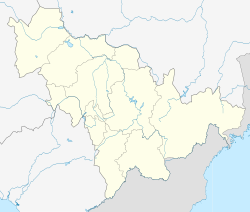Hunchun
Hunchun
珲春市 · 훈춘시 | |
|---|---|
 A street in Hunchun | |
| Coordinates: 42°52′N 130°22′E / 42.867°N 130.367°E | |
| Country | China |
| Province | Jilin |
| Prefecture | Yanbian |
| Seat | Xin'an Subdistrict |
| Area | |
| • Total | 4,938 km2 (1,907 sq mi) |
| Elevation | 41 m (135 ft) |
| Population | |
| • Total | 220,000 |
| • Density | 45/km2 (120/sq mi) |
| Time zone | UTC+8 (China Standard) |
| Postal code | 133300 |
| Hunchun | |||||||
|---|---|---|---|---|---|---|---|
| Simplified Chinese | 珲春市 | ||||||
| Traditional Chinese | 琿春市 | ||||||
| |||||||
| Chinese Korean name | |||||||
| Chosŏn'gŭl | 훈춘시 | ||||||
| |||||||
| South Korean name | |||||||
| Hangul | 훈춘 시 | ||||||
| |||||||
Hunchun is a county-level city in the Yanbian Korean Autonomous Prefecture, far eastern Jilin province, Northeast China. It borders North Korea (North Hamgyong province) and Russia (Primorsky Krai), has over 250,000 inhabitants, and covers 5,145 square kilometers.[1] It was capital of Balhae/Bohai Kingdom between 785-793 as "Dongyang". The city's name Hunchun comes from the Manchu language meaning borderland.
The city is located near the point of junction of the borders of China, Russia, and North Korea; provided with an observation platform, it is a popular tourist attraction.[2]
Administrative divisions
Hunchun has four subdistricts, four towns, and five townships.[3]
Subdistricts:
- Xin'an Subdistrict (新安街道 / 신안가도), Jinghe Subdistrict (靖和街道 / 정화가도), Henan Subdistrict (河南街道 / 하남가도), Jinhai Subdistrict (近海街道 / 근해가도)
Towns:
Townships:
- Hadamen Township (哈达门乡 / 합달문향), Machuanzi Township (马川子乡 / 마천자향), Mihong Township (密江乡 / 밀강향), Sanjiazi Manchu Ethnic Township (三家子满族乡 / 삼가자 만주족 향), Yangbaozi Manchu Ethnic Township (杨泡子满族乡 / 양포자 만주족 향)
Economy
Since the early 1990s, the Chinese government invested a lot in transforming Hunchun into a regional economic center. On 9 March 1992 the Chinese parliament approved to set up Hunchun Border Economic Cooperation Zone. The national government and Jilin provincial government have invested in succession over four billion yuan in Hunchun through the 1990s.[4]
On 16 March 2013, a joint agreement to export textiles to North Korea was announced.[5][6] The textiles would be made into up to 8,000 shirts in North Korea and exported back to China.[5][7]
- Hunchun Border Economic Cooperation Zone
Hunchun Border Economic Cooperation Zone was approved to be national-level border economic cooperation zone in 1992, with a planning area of 24 km2. In 2002 and 2001, Hunchun Export Processing Zone and Huichun Sino-Russia Trade Zone was set up in it. Being located in the junction of China, Russia, and Korea, it enjoys a strategic location. The infrastructure is available. The city focuses on the development of sea food processing, electronic product manufacture, bio-pharmacy, textile industry and other industries.[8]
- Hunchun Export Processing Zone
Hunchun Export Processing Zone is located in 5 km2 area in Hunchun Border Economic Cooperation Zone. Its planned area is 2.44 km2. It enjoys good infrastructure and policies as its parent zone does.[9]
Transport
In the early 1990s, Jilin province government constructed a railway and improved the highway to Hunchun. The Tumen River Bridge connects between Hunchun and the North Korean town of Wonjeong (Korean: 원정). The bridge was built during the Japanese occupation in 1938. In 2010 the bridge was renovated as part of an agreement between North Korea and China to modernize the Rason port in North Korea.[10] In addition, a new railway line was constructed which links Hunchun and Makhalino (a station on the Ussuriysk-Khasan line, 41 km before Khasan) in Russia and began operating in February 2000.[11] Hunchun port is 42 km from Posyet and 63 km from Zarubino port towns of Russia.
A 250-km/h high-speed passenger rail line from Jilin to Hunchun via Tumen (吉图珲铁路客运专线) is under construction.[12] Construction work started in January 2011, and service is expected to start at the end of September 2015.[13] The railway has been described as "Dongbei's most beautiful railway" (due to the terrain it runs through) and "the fastest way to Vladivostok" (4 hours by train from Shenyang to Hunchun, plus 4 hours by bus from Hunchun to Vladivostok).[14] Reflecting the border location of the city, the new train station has its sign in four languages: Chinese, Korean, Russian, and English.[2]
References
- ^ http://www.nkeconwatch.com/2009/11/17/china-approves-tumen-border-development-zone/
- ^ a b Rob Schmitz, China bets big on border town with Russia, North Korea, 2015-11-16
- ^ "延边朝鲜族自治州-行政区划网 www.xzqh.org" (in Chinese). xzqh.org. Retrieved 2011-04-28.
- ^ "A survey of Hunchun". Office of the TCDC/ECDC Network in China. Archived from the original on 2008-04-07. Retrieved 2008-02-09.
{{cite web}}: Unknown parameter|deadurl=ignored (|url-status=suggested) (help) - ^ a b Rank, Michael (March 16, 2013). "China signs first offshore processing agreement with North Korea". NK Economic Watch. Retrieved 19 March 2013.
- ^ 吉林对朝出境加工业务运行 (in Chinese). IDPRKorea.com. 2013-03-07. Archived from the original on 22 November 2014. Retrieved 19 March 2013.
{{cite web}}: Unknown parameter|deadurl=ignored (|url-status=suggested) (help) - ^ 吉林对朝出境加工业务运行 (in Chinese). IDPRKorea.com. 2013-03-07. Archived from the original on 22 November 2014. Retrieved 19 March 2013.
{{cite web}}: Unknown parameter|deadurl=ignored (|url-status=suggested) (help) - ^ RightSite.asia | Hunchun Border Economic Cooperation Zone
- ^ RightSite.asia | Hunchun Export Processing Zone
- ^ Bridge on China-North Korea border being renovated
- ^ Kawamura, Kazumi. "Nine Transportation Corridors in Northeast Asia and Their Discontinuous Points". The Economic Research Institute for Northeast Asia. Retrieved 2008-02-09.
- ^ http://www.jl.xinhuanet.com/newscenter/2010-10/31/content_21272383.htm
- ^ 吉图珲铁路有望7月试运行 (Jilin Ribao, 2015-04-16)
- ^ http://news.huochepiao.com/2015-6/2015626933445.htm

